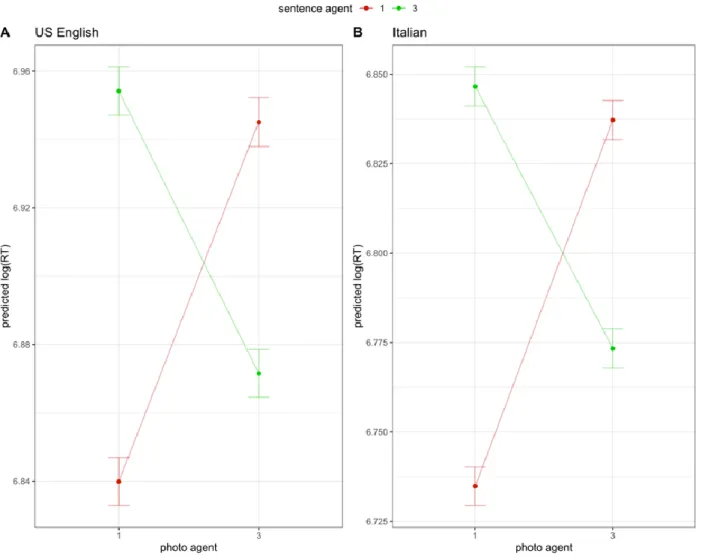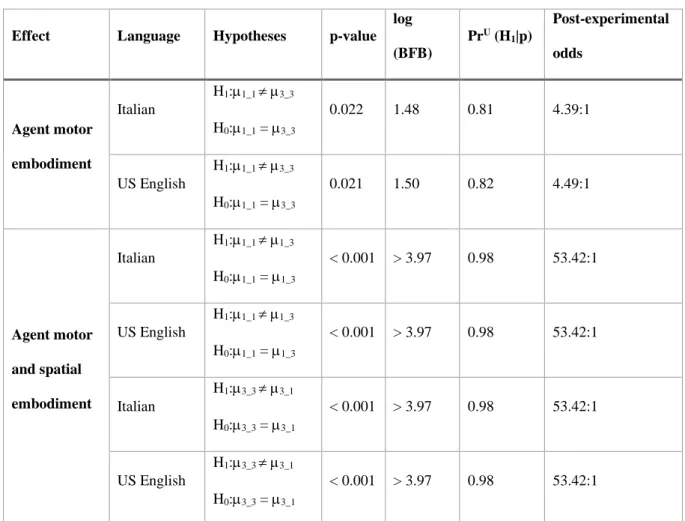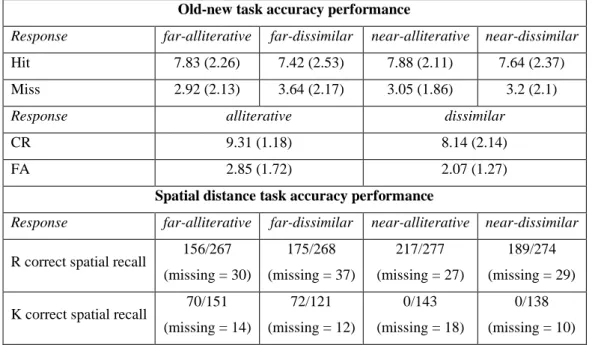LANGUAGE AND SPACE FROM AN EMBODIED PERSPECTIVE
According to a review by Körner and colleagues (Körner et al., 2016), the body and the sensorimotor system can have three different effects on cognition. For example, using the first-person pronoun increases immersion when reading a narrative (Hartung et al., 2016). For example, Glenberg and colleagues (Glenberg et al., 1987) showed that comprehension is influenced by the spatial structure of the events described in the text and affects the process of foregrounding.
Recently, Gianelli and colleagues (Gianelli et al., 2011) studied the influence of spatial information on ACE. However, in a subsequent study, Brunyé and co-authors partially failed to replicate this finding (Brunyé et al., 2016).
THE PRESENT WORK
It is not clear whether other aspects of language and perception, such as phonology, show the same connection to space. Specifically, if the concept of spatial ... proximity/distance induced by similar/dissimilar phonology is stored offline in the declarative memory system. This thesis aims to elucidate at a macroscopic level the interaction between spatial cognition and language in the context of ES, but has additional specific goals that will help to better understand the mechanisms of ES.
LLE REPLICATION STUDY
According to this theory, while reading a sentence, we build a mental model of the content that includes all the elements and actions described in the sentence. Later, we process more quickly and efficiently those elements of the model that were associated with the participant (Glenberg et al., 1987). All participants provided written informed consent approved by the University of Hartford Institutional Review Board and.
Participants gave written informed consent as approved by the Ethics Committee of the Catholic University of Milan and participated in the study without any compensation. Press and hold BLUE to go to the next sentence.” For the near response, only this part has been changed “Press the YELLOW button if the sentence is not correct, if it is correct, press the RED button.” The order of blocks, with "yes-is-almost" or.

SPATIAL CONTEXT AND SENTENCE SIMULATION
Significantly and differently from previous studies, I manipulated agency (who plays) both in the sentence and in the photograph. In the first congruent condition, the participant is the agent in the sentence (i.e., “I give John the pen”) and the photograph (i.e., the egocentric photograph shows the participant's hands in action). In incongruent conditions, there is a mismatch between the agent in the sentence and the one in the picture.
In the latter case, motor simulation and spatial perspective will not overlap, and the picture will match only in the perspective of the action, but not in its direction. The actor in the picture was right-handed and always performed the actions with the right hand. Consequently, the agent in the congruent condition was the same in the sentence and the picture, while the agent in the incongruent pairs was not the same in the sentence and the picture.
The following formula is used in the R code: [image verification RT ~ fixed effect + (1|participant ID) + (1|stimulus pair ID)]. In the first analysis block, participants and stimulus pairs were placed as RE and the variables. This again indicates that most of the variability in the RT was due to differences between participants.
In the second block of analysis, I place participants and stimuli pairs as an RE and the variable. The results were consistent also when hand dominance of the participant was added in the model (main effect and interaction with Sentence-Photo Pairs effect not significant). Indeed, in the 1_1 condition the subject of the sentence is the agent of the action, therefore motor simulation and spatial perspectives overlap.
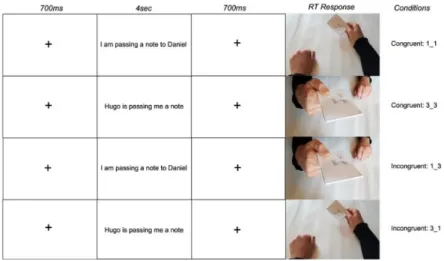
SPATIAL FRAMES OF REFERENCE AND SENTENCE SIMULATION
I expect the egocentric performance, which is the participant's ability to establish a new set of egocentricity. The pronouns (in Italian) were always in first or last place to reduce the influence of the position of the pronoun. Sentences were also gender balanced (Maria/Gianni) so that half of the action is abstract.
In the encoding phase, the sentences were presented in the center of the screen for 5 seconds, followed by a 500ms fixation cross. You will be asked to replace each object several times, regardless of the correctness of your answer”. Generalized (logistic) linear mixed-effects model (GLMM) ANOVA with Type III Wald chi-square test was used to examine the effect of the two categorical (action sentence type: concrete or abstract; sentence agent: 'You' or a third person ) predictors and the egocentric and allocentric spatial memory error on the correctness (0 = incorrect; 1 = correct) old–new responses.
The intraclass correlation coefficient (ICC) was used to examine the impact of the random effects on the dependent variable. I investigated the effect of the conditions (Sentence Agent and Sentence Type) with a 2x2 within linear mixed-effects ANOVA (Luke, 2017). Conversely, the trends of the concrete sentences in the first- and third-person perspective were statistically different (p = 0.014).
However, for the Sentence Type by Allocentric Error interaction, I found that the trends for abstract and concrete action sentences were statistically different (p = 0.043). Indeed, allocentric memory predicts to a greater extent the ability to recall abstract action sentences and to a lesser extent knowledge of concrete action language regardless of agent (first vs. third person). It is possible for the participant, to remember the article, to simulate the content of the sentence and especially this one.
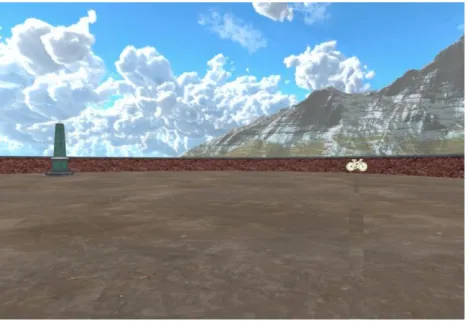
SPATIAL DISTANCE AND PHONOLOGICAL SIMILARITY
The fixed noun was placed in the middle of the lower part of the computer screen. In the encoding phase, participants were instructed to notice and memorize the word pairs (intentional encoding), so the implicit task was encoding the spatial locations of each noun pair. After both R and K responses, they had to judge the distance of the moving noun from the fixed one.
The start position of the shift button was at the center of the shift range (i.e., the location of the fixation cross). Finally, if the participant answered 'new', the next noun pair was presented, skipping the RC section of the task (and consequently the spatial . judgment task). The encoding of the noun pairs' phonological similarity (alliterative-dissimilar) and spatial location (near-far) were the fixed effects.
Conversely, if the slider tool dot was placed in the opposite portion of the screen, responses were scored as incorrect (e.g., if the slider dot was placed above the fixation cross—far portion—but at encoding the moving noun was below the cross—near after the fixed noun – the response was incorrect). CR and FA do not have spatial encoding positions because they were not shown in the encoding phase of the task. The dashed line represents the boundary of the near and far portions of the screen relative to the fixed noun (i.e., fixation cross position).
Boxplots show the recalled distance (range 0-5) of movement from a fixed word during the spatial distance task. Regarding the spatial distance estimate by R, participants provided only 18 (six for different pairs) responses, and the observed power of the LMM ANCOVA was 10%. These parameters help understand how much evidence there is in favor of an alternative relative to the null hypothesis.

CONCLUSIONS
Potrebbe essere possibile che la capacità di ricordare (e implementare) prospettive in terza persona, frasi di azioni concrete, sia prevista dall'abilità egocentrica. Nello studio 3, abbiamo dimostrato che la capacità di simulare (offline) il punto di vista di un agente in terza persona in frasi di due caratteri è prevista dall'abilità di memoria spaziale egocentrica del lettore. Luca mi tira un elastico Terza persona Tiro un elastico a Sofia Prima persona Sara mi versa l'acqua Terza persona Verso l'acqua per mio padre Prima persona Marco mi porge il pallone Terza persona Do a Mario il pallone Prima persona Mario mi dà un biglietto Terza persona mando un biglietto a Mario Prima persona Carlo mi restituisce la pallina Terza persona restituisco la biglia a Sandro Prima persona Emma mi dà la pallina di carta Terza persona restituisco la pallina a Nadia Prima persona Giulia mi presta la penna Terza persona do la penna a Laura Prima persona Paolo mi porge il vassoio Terza persona do il vassoio a Marco Prima persona Chiara mi offre un gelato Terza persona do un gelato a Claudia Prima persona Claudio mi porge il taccuino Terza persona io consegna il quaderno a Sara Prima persona Livio mi dà la palla Terza persona Do la palla a Luca Prima persona Claudio mi dà la bambola Terza persona Do la bambola ad Anna Prima persona Bruno mi dà le carte Terza persona Do le carte a Laura Prima persona Maria mi affida le chiavi Terza persona Consegno le chiavi a Sandra Prima persona Luca mi consegna il rancio Terza persona Do il rancio a Dario Prima persona Paola mi restituisce la macchina Terza persona Restituisco la macchina ad Alessia Prima persona consegna Fulvio io soldi Terza persona do soldi a Marco Prima persona Anna mi dà soldi Terza persona do soldi a Laura Prima persona.
Alessia me premiando met una medaglia Third Person Sto premiando Sonia met una medaglia First Person Bruno me sta consenando la pizza Third Person Sto consenando la pizza a Dario First Person. I give a note to Daniel in First Person Charles gives me back the marble Third Person I give the marble back to Alex First Person Emma gives me a paper ball Third Person I give a paper ball to Ella First Person. I give the money to Marc First Person Hanna donates money to me Third Person I donate money to Laura First Person Alexia awards me a medal Third Person.
I'm giving Bobbie a medal.
